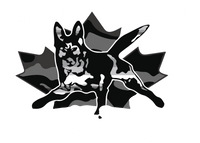Agricultural Division
Clubroot Detection
If dogs can detect trace amounts of narcotics in suitcases, can they be trained to detect plant disease too? The answer is yes.
Currently, High Drive K9 Services have 2 German Shepherds trained to detect clubroot. As of June 2020 there are a total of 7 strains of clubroot. The owner of High Drive K9 Services, Chad Hanlon, is currently working and keeping up to date the training of his detection dogs on all current strains of clubroot.


There are several advantages to using our dogs to sniff out clubroot. First, it's quicker than having a person walk a field looking for stunted or damaged plants, and then digging them up to see if they have galls. It might also be a way to detect the presence of the disease when an infestation is at a very early stage.
Dogs will alert by barking, putting their nose on the infected canola plant, or by digging.
We put GPS collars on the dogs so we can map the fields and see where the dogs indicated on the scent source. The results can be mapped down and shown to our clients. Another option is to use our pipeline detection flags.
Our dogs can detect the presence of clubroot galls through sniffing. This will help farmers control a developing outbreak or manage fields differently to mitigate the problem.
Clubroot is hard to detect in canola, at least above ground. Sickly looking plants, patchy stands and odd flowering patterns could be caused by a number of conditions. Pulling up plants and checking for the presence of galls on the roots is the only way to confirm clubroot, and that can mean a time-consuming process of destruction and examination. With our dogs, we can search in a fraction of the time and cause no destruction.
Clubroot, which is soil-borne, has a firm foothold in Alberta fields surrounding Edmonton and is gradually spreading outward.

Why is it of concern?
Most varieties of canola, mustard and cole crop vegetables currently being grown in Alberta are highly suitable to clubroot. This disease is capable of significantly reducing yield and quality, and may destroy a crop if infestation levels are high. Swedish researchers found that infestations in canola fields nearing 100 percent affected plants caused about 50 to 80 percent yield loss; while infestations of 10 to 20 percent led to 5 to 10 percent yield loss. These results are similar to sclerotinia stem rot infection in canola, where a general rule of thumb is that estimated yield loss is half of the percentage of infected stems. A few cases of total crop loss have been reported in Alberta.
